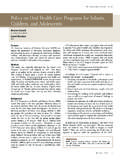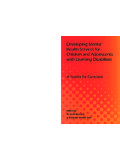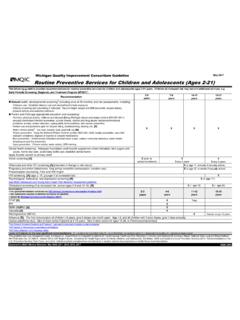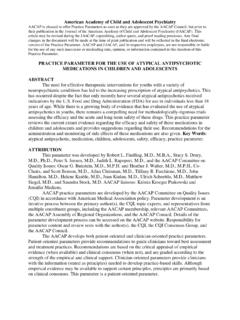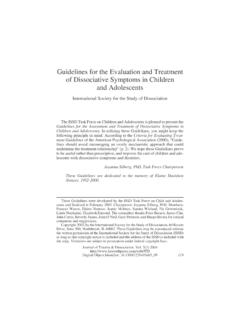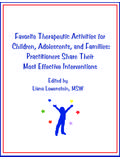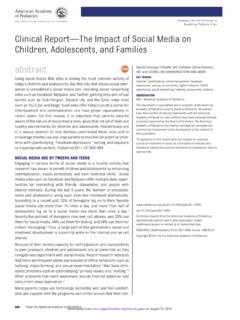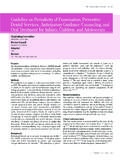Transcription of Guideline on Acquired Temporomandibular …
1 272 CLINICAL PRACTICE GUIDELINESREFERENCE MANUAL V 37 / NO 6 15 / 16 PurposeThe American Academy of Pediatric Dentistry (AAPD) recog- nizes that disorders of the Temporomandibular joint (TMJ), masticatory muscles, and associated structures occasionally occur in infants, children, and adolescents. This Guideline is intended to assist the practitioner in the recognition and diag- nosis of Temporomandibular disorders (TMD) and to identify possible treatment options.
2 It is beyond the scope of this document to recommend the use of specific treatment document is an update of the previous document, revised in 2010. The update included an electronic search using the following parameters: Terms: Temporomandibular disorder, TMJ dysfunction, TMD AND adolescents, TMD AND gender differences, TMD AND occlusion, TMD AND treatment; Fields: all fields; Limits: within the last 15 years, humans, English, clinical trials.
3 The reviewers agreed upon the inclu- sion of 78 references to support this Guideline . When data did not appear sufficient or were inconclusive, recommend- ations were based upon expert and/or consensus opinion by experienced researchers and clinicians. Background Definition of TMDTMD is a collective term for a group of musculoskeletal and neuromuscular conditions which includes several clinical signs and symptoms involving the muscles of mastication, the TMJ, and associated While TMD has been defined as functional disturbances of the masticatory system ,2 others include masticatory muscle disorders,3 degenerative and in- flammatory TMJ disorders.
4 4 and TMJ disk displacements5 under the umbrella of TMD. In a recent update, the American Academy of Orofacial Pain divided TMD in two broad categories: TMJ disorders and masticatory muscle of TMD in children and adolescentsThe reported prevalence of TMD in infants, children, and adolescents varies widely in the This variation may be due to differences in populations studied, diagnostic criteria, examination methods, and inter- and/or intra-rated variations of examining ,12 Prevalence of signs and symptoms increases with age.
5 One study reported the TMD-related symptoms were rare in three- and five-year-olds whereas five to nine percent of 10- and 15-year olds reported more severe Another found percent of adol- escents aged 12-19 years reported TMD A study of the primary dentition reported 34 percent of patients with signs and/or symptoms of This could, in part, be due to inclusion of muscular signs versus symptoms. An epide-miological study of 4724 children aged five through 17 years reported 25 percent with symptoms.
6 Clicking was seen in percent of children in the primary dentition and percent in late mixed dentition, and further increased to percent in patients with permanent Headaches appear to be independently and highly associated with TMD in adol- escents, with headaches most commonly occurring before the onset of TMD pain (odds ratio ).17 Although TMD pain in children increases with age in both boys and girls, recent surveys have indicated a significantly higher prevalence of symptoms and greater need for treatment in girls than boys18 with the development of symptomatic TMD correlated with the onset of puberty in ,20 For ages 16-19 years.
7 Percent of girls compared to percent of boys reported school absences and analgesic consumption due to TMD of TMDT emporomandibular disorders have multiple etiological fac- Research is insufficient to reliably predict which pa- tients will or will not develop TMD as most published investigations evaluate static, morphologic variables rather than study the dynamic relationship between the joint and the teeth during There are predisposing (or risk) factors, precipitating (or initiating)
8 Factors, and perpetuating Originating Committee Clinical Affairs Committee Temporomandibular Joint Problems in Children SubcommitteeReview CouncilCouncil on Clinical AffairsAdopted 1990 Revised1999, 2002, 2006, 2010, 2015 Guideline on Acquired Temporomandibular Disorders in Infants, Children, and Adolescents AMERICAN ACADEMY OF PEDIATRIC DENTISTRY CLINICAL PRACTICE GUIDELINES 273(or sustaining) factors that contribute to the development of Many studies show a poor correlation between any single etiological factor and resulting signs (ie, findings identi- fied by the dentist during the examination) and symptoms (ie, findings reported by the child or parent).
9 Alterations in any one or a combination of teeth, periodontal ligament, the TMJ, or the muscles of mastication may lead to Furthermore, systemic and psychosocial factors may reduce the adaptive capacity of the masticatory system and contribute to Etiologic factors suggested as contributing to the develop- ment of TMD are: 1. Macrotrauma: This would include impact injuries such as trauma to the chin. A common occurrence in childhood because of falling, chin trauma is reported to be a factor in the development of TMD in pediatric Additional macrotraumatic injuries occur due to motor vehicle accidents, sports, physical abuse, forceful intuba-tion, and third molar Unilateral and bilateral intracapsular or subcondylar fractures are the most com- mon mandibular fractures in Closed reduction and prolonged immobilization can result in.
10 31 Improperly treated fractures may result in facial asym- ,31 2. Microtrauma from parafunctional habits: Bruxism, clenching, hyperextension, and other repetitive habitual behaviors are thought to contribute to the development of TMD by joint overloading that leads to cartilage breakdown, synovial fluid alterations, and other changes within the Bruxism may occur while the patient is asleep or awake; sleep bruxism is a different entity from daytime bruxism.




